Spongy moth eggs are laid in a fuzzy, tan-colored mass. The egg mass contains 500-1,000 eggs and is about the size of a quarter. Eggs are laid during late summer and hatch the following spring. Egg masses can be found on both living and inanimate objects, including:
- nursery stock
- logs
- roof eaves
- wheel wells
- firewood
- lawn chairs
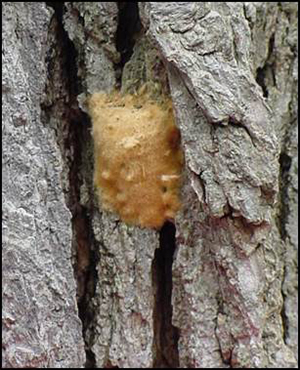 Egg mass
Egg mass
This is the life stage that is most likely to be transported by humans.
Spongy moth eggs are laid in a fuzzy, tan-colored mass. The egg mass contains 500-1,000 eggs and is about the size of a quarter. Eggs are laid during late summer and hatch the following spring. Egg masses can be found on both living and inanimate objects, including:
- nursery stock
- logs
- roof eaves
- wheel wells
- firewood
- lawn chairs
 Egg mass
Egg mass
This is the life stage that is most likely to be transported by humans.
The caterpillar hatches from the egg and grows to a length of 2½ inches as it matures. Its body is covered with hairs to protect it from predators. Along its back, the caterpillar has five pairs of blue spots near the head followed by six pairs of red spots. It actively feeds on plant foliage from late spring through mid-summer.
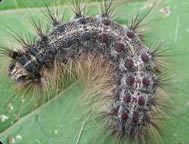 Caterpillar (larva)
Caterpillar (larva)The caterpillar hatches from the egg and grows to a length of 2½ inches as it matures. Its body is covered with hairs to protect it from predators. Along its back, the caterpillar has five pairs of blue spots near the head followed by six pairs of red spots. It actively feeds on plant foliage from late spring through mid-summer.
 Caterpillar (larva)
Caterpillar (larva)The pupa is an immobile stage of this insect's life. Though it appears inactive, it is very busy inside transforming from a caterpillar into an adult moth. Found during mid-summer, it is dark reddish-brown, leathery in appearance, and often tethered to an object with silk strands. Pupae can range in size from ¾ inch to 1½ inches long.
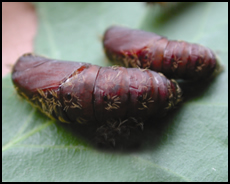 Pupa
Pupa
The pupa is an immobile stage of this insect's life. Though it appears inactive, it is very busy inside transforming from a caterpillar into an adult moth. Found during mid-summer, it is dark reddish-brown, leathery in appearance, and often tethered to an object with silk strands. Pupae can range in size from ¾ inch to 1½ inches long.
 Pupa
Pupa
The adult female moth is white with brown jagged markings on her wings. Her wingspread ranges from 1 to 2 inches, but she cannot fly. Female spongy moth attracts males by releasing a pungent sex attractant (pheromone). After attracting a male and successfully mating the female lays a single egg mass and dies. Adult moths are typically active from late summer through early fall.
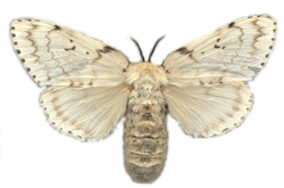 Adult Female
Adult Female
The adult female moth is white with brown jagged markings on her wings. Her wingspread ranges from 1 to 2 inches, but she cannot fly. Female spongy moth attracts males by releasing a pungent sex attractant (pheromone). After attracting a male and successfully mating the female lays a single egg mass and dies. Adult moths are typically active from late summer through early fall.
 Adult Female
Adult Female
The adult male moth has feathery (plumed) antennae that are so sensitive they can "smell" a female a mile away. His body can be light beige to dark brown with black jagged bands on brown forewings. His wingspread ranges from only ¾ to 1½ inches, he is a strong flyer and capable of mating with several females. Adult moths are typically active from late summer through early fall.
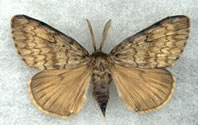 Adult Male
Adult Male
The adult male moth has feathery (plumed) antennae that are so sensitive they can "smell" a female a mile away. His body can be light beige to dark brown with black jagged bands on brown forewings. His wingspread ranges from only ¾ to 1½ inches, he is a strong flyer and capable of mating with several females. Adult moths are typically active from late summer through early fall.
 Adult Male
Adult Male

